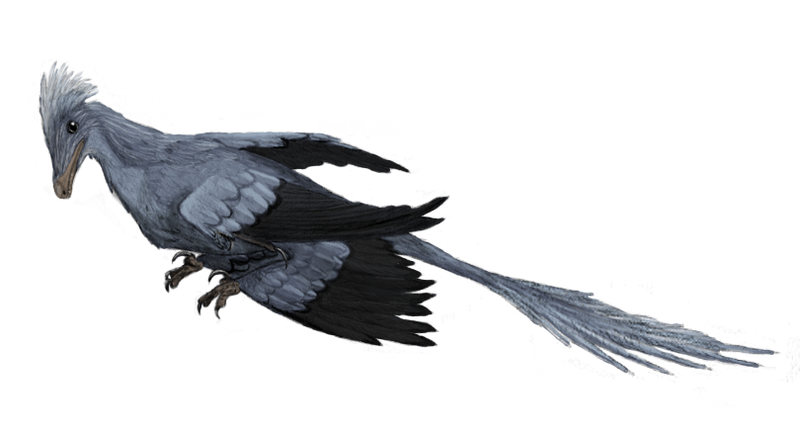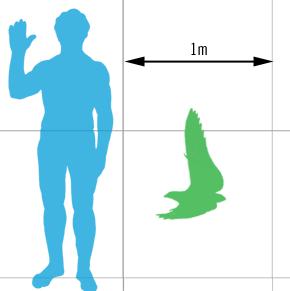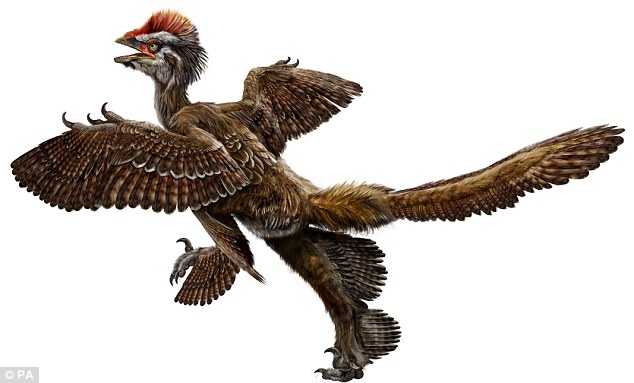The origin of bird flight is one of the greatest stories evolution has ever told us in the history of life on this planet. To imagine how organisms that once ran around on the ground have descendants that soar through the skies is truly phenomenal, and represents a truly great leap in increasing the awesomeness of these animals. The secret of how it came about though is hidden away in the fossil record, with the mysterious tale ever-shifting as our understanding of early birds and feather precursors evolved.
One aspect of the evolution of flight that has confounded palaeontologists for some years now, is whether early birds went through a quad-wing experimental phase on the way to full and solely forelimb-powered flight, as in modern birds. Previous hypotheses have looked at dinosaurs closely related to the bird lineage such as Microraptor, a paravian closely related to dromaeosaurids such as Velociraptor, where the fossils have shown four feathered limbs. These were organised in a ‘staggered biplane’ formation, and as a transition state on the way to just forelimb wings. However, along the avian lineage, hindlimb wings are known more scarcely, only among the infamous Archaeopteryx and one other species.

Artist’s reconstruction of Microraptor, with colour determined using fossilised melanosomes. Source.
Until now that is. A team of palaeontologists from China dug deep into their vast collections of feathered theropods unearthed from the vast deposits of the Jehol Group from the Early Cretaceous of China (about 133-120 million years old). Among this treasure trove, they found 11 new specimens all possessing some form of hindlimb feathers. Several specimens can be referred to the genus Sapeornis, the ornithuromorph Yanornis, several are confuciusornithids, and several belong to the group Enantiornithes, all groups of early birds. They have a varied range of hindlimb feather arrangements and morphologies, all of them being assigned to the ‘pennaceous’ feather type, being designed for a flight function, except for the ornithuromorphs which have a plumulaceous (soft and downy) morphology as well as the pennaceous type (similar to modern birds).

Previous reconstructions of Sapeornis, with human-about-to-be-hit-by-Sapeornis for scale. Source.
Importantly, these hindlimb feathers are arranged in such a manner that suggests they provided aerodynamic capability through either providing lift, reducing drag, or improving the manoeuvrability of the animal. Their presence in deinonychosaurians like Microraptor as well as in an assortment of early birds supports the idea that in the evolution of flight, the presence and function of hindlimb feathers played an important role. The varied morphology of these also implies that there was no single route to finding the ‘perfect’ feather or wing arrangement, and that there were a range of morphologies that supported adaptation for flight capability.
What you can do with specific traits like this (traits are aspects of an organism that ecologically interact), is map them on to a tree of evolutionary relationships within the group. The team did this with basal paravians and the presence of forelimb and hindlimb feathers, finding that the two traits evolved in synchrony to begin with, but then the leg feathers began to be reduced and eventually lost, consistent with the timing of scale formation on the feet of these birds. Rather awesomely, in modern birds, a bit of genetic fiddling during the embryonic stages of development allows you to switch between scaled and feathered feet by expressing certain genes at certain stages. This is pretty much recreating traits that resemble the ancestral species (!!), and emphasises the ‘ontogeny recapitulates phylogeny’ theory, where the early developmental stages of organisms represent the adult stages of their ancestors.

How many different dinosaur and bird lineages experimented with feather configuration? Reconstruction of the troodontid Anchiornis huxleyi. Source.
Rather timely, a new study just out too suggests that flight capability might be closely tied to reproductive capability in early birds. So there are many variables to account for when considering the evolution of flight, not just the geometry and position of feathers, such as the weight and muscle strengths of an organism, and their locomotory capabilities. We’re still learning about the evolution of flight, but these specimens provide valuable insight into how early birds experimented with numerous different morphological combinations, instead of a simple linear transition between types. Still plenty more chapters to fill in this book!
Reference:
Zheng et al. (2013) Hind wings in basal birds and the evolution of leg feathers, Science, 339, 1309-1312 (not free to read, unfortunately – hence blogging about it!)

Gary Kaiser
Great stuff but perhaps their is an alternative to the ‘biplane’ format. In flying birds the elbow and the knee are moved close to a line through the centre of mass. In a bird with long leg feathers, that posture might create a single large lifting surface along the length of the body (as in bats and pterosaurs) and assist with balance in the air. Some of the images in Matthew Martyniuk’s “Fieldguide to Mesozoic Birds” show convincing birds in this conformation. The format also offers an alternative to C.J. Pennycuick’s hypothetical post-humeral patagium.
Jon Tennant
Oh wow, that’s awesome! Not sure if it would be possibly to detect such a precise configuration in the fossil record though. Maybe with a bit of ‘looking really hard’.. 😉
Pingback: Fossil feathers are frickin’ sweet | Green Tea and Velociraptors